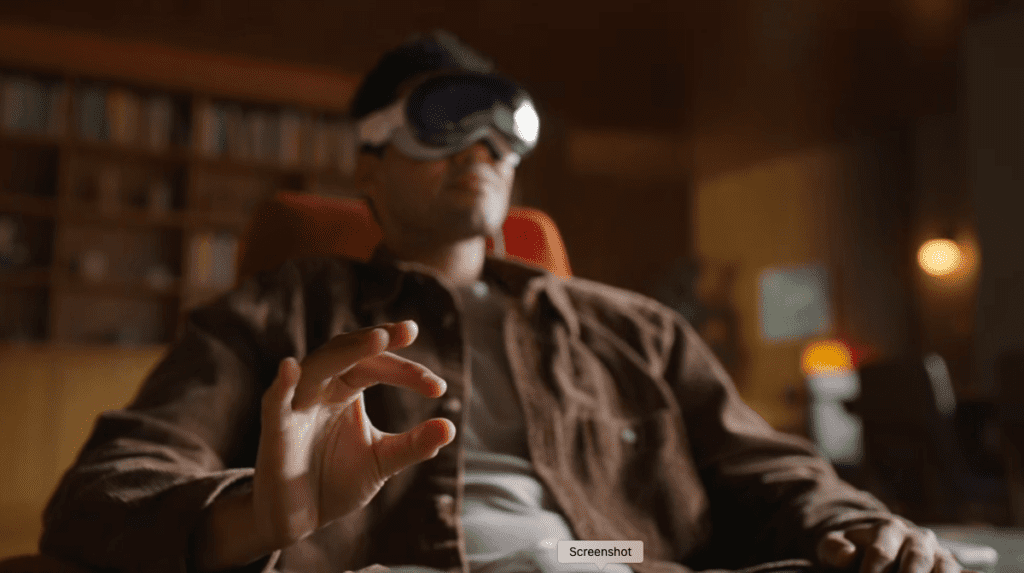Apple Launches New Vision Pro AR Headset

Apple unveiled its first augmented reality headset at WWDC 2023. The new Apple Vision Pro is designed to offer an excellent display of VR content with extremely high-resolution and radiantly bright mini displays.
The Apple Vision Pro is of course celebrated by the manufacturer itself as a “revolutionary new product” and is intended to represent a “new kind of computer”, whereby for the first time one looks “not on, but through” the computer. The interaction with the device is handled by the user’s hands, eyes and voice. Externally, the device is reminiscent of giant ski goggles, with a digital crown on the housing and many fabric covers.
If Apple has its way, the Vision-Pro headset should merge the digital and real worlds. The interface is designed in three dimensions, so the user should be able to move “in space”, with the apps being able to be freely arranged according to the user’s wishes. Of course, apps can also be displayed over the entire surface, but they can also surround the user so that he can practically move through them. For this purpose, the “digital crown” on the edge of the case is used to regulate the “immersion” in size.
Placed freely in the room: App display on the Vision Pro headset
Apparently, Apple is initially focusing on offering the apps known from its other platforms for the Vision Pro headset. If you put on the headset, all apps are displayed first, whereby the display is also in the form of windows that can be placed anywhere in the room.
All known Mac and iPhone apps should also be able to be synchronized with the headset. Safari, Messages, Apple TV, and various other apps are also available on the device. Of course, other software manufacturers are also on board, so that practically all apps available for iOS and iPadOS can be used on the headset. Even Microsoft is there because Teams and other Office applications should also be able to be used on the huge virtual screen of the Vision-Pro.

The voice control using Siri is apparently deeply integrated because as one of the usage examples, Apple showed how the user can simply look at the search input field and then speak to start a query. Alternatively, the headset can also be used with peripheral devices connected via Bluetooth, such as a keyboard, trackpad, or mouse, which Apple wants to use to make tedious tasks easier, such as writing e-mails or the like.
Alternatively, according to Apple, the Vision Pro can be used as a kind of display for a Mac, allowing the computer’s desktop to be viewed and magnified in the AR display. Speaking of the display: Behind the large glass cover on the front of the headset, Apple even integrates an additional, practically full-surface display, which makes the user’s face visible to the outside and is also used to show the outside world when the user is currently using the VR applications over the entire surface uses – i.e. can no longer see his surroundings.

The external battery pack allows up to two hours of run time
When it comes to the hardware, Apple relies on separating the headset from the power supply. So while the user wears the Vision Pro headset on their head, they wear the associated battery pack elsewhere on their body. The headphones are attached to the woven fabric strap used to wear the headset on the head.
Apple states the battery life as only two hours in connection with the external battery pack. However, continuous operation should also be possible if the device is connected to a power supply unit by cable. Several color variants of the headset are apparently planned because Apple already showed a black and a white version during its event today.

Extremely high-resolution mini displays & optics from Zeiss
The displays of the Apple Vision Pro deliver an extremely high resolution, which should provide each eye with more than 4K quality, whereby the correction lenses available for the headset were developed in cooperation with the German optics specialist Zeiss, via which the image of the small curved Micro-OLED screens is directed into the wearer’s eyes when wearing glasses. Overall, the panels should offer “23 million pixels”.
The technical basis is an Apple M2 SoC, i.e. the same ARM SoC that also runs in Apple notebooks, tablets, and desktop Macs. It is supported by an additional chip called “R1”, which is responsible for the real-time tracking of the eyes and the evaluation of the four external cameras and other sensors on the Vision Pro.
A total of four external cameras capture the user’s surroundings, with two of the sensors facing downward to detect hand movements and gestures. In addition, there are infrared sensors and even a LiDAR sensor, with which the environment of the wearer of the Vision Pro is recorded. The integration of these sensors already makes it clear that Apple probably has a lot more planned. IR sensor technology for eye tracking is arranged around the user’s eyes.
Apple plans to make the Vision Pro headset commercially available early next year, initially with an official starting price of $3,499.
Research Snipers is currently covering all technology news including Google, Apple, Android, Xiaomi, Huawei, Samsung News, and More. Research Snipers has decade of experience in breaking technology news, covering latest trends in tech news, and recent developments.












